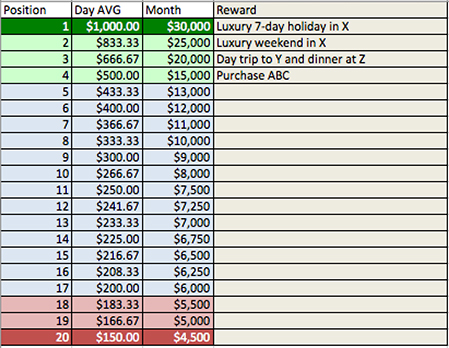6 Reasons Why Campaigns Fail (And How to Fix Them)
It’s 300 years since alchemy went out of fashion, but some affiliates still believe in the principle of a philosopher’s stone:
A magic formula that can turn very average materials in to gold.
It’s catnip for affiliates.
“What one technique can I inject in to my marketing for transformative results?”
Be careful with this mindset.
My view is that pragmatism will bring you closer to success.
I believe ‘getting it right’ is less a pursuit of magic formulas, and more a game of cutting out enough mistakes to understand simply what is.
In this post, I have listed six reasons why campaigns fail.
We’ll start with the very obvious…
#1. You bypass research and the process of idea elimination.
If you skip research, you will launch half-baked campaigns.
Research can be as simple as asking your account manager whether an offer has received traffic from other affiliates.
“Did it convert for them?”
If the answer is no, or more likely — a polite deflection, and a suggestion to run Offer Y instead — consider that an important insight.
Many campaigns avoid failure if subjected to criticism before your mind has raced away with the imaginary profits.
I often tell affiliates to stick to one traffic source.
A good reason for this is to develop your understanding of the platform’s ecosystem.
- What is a good CTR?
- What is an average CPM?
- How high do I have to bid to get traffic?
- How much traffic can I get in this country?
By focusing your efforts on a single platform, you will establish baseline performance metrics.
This information helps you eliminate dozens of campaign ideas where the maths are stacked against you.
How fast you eliminate bad ideas is a key factor of success.
Before launching any campaign: detach yourself as the author.
Imagine you are vetting it for a complete newbie.
Now, unleash the cynic inside.
Establish the key assumptions that must be proven true for the campaign to succeed.
“He’ll need a CTR of at least 30% to break even.”
“If he’s direct linking, he’ll need to convert at 3%.”
“He’ll need enough margin to bid $1.50 if he wants traffic in Germany.”
Then ask yourself:
What evidence do I have against this amateur bumberclart succeeding where others have failed?
If you can’t find any, steal his campaign.
#2. You run too many campaigns.
How many campaigns are you juggling today?
Dunbar’s number: By using the average human brain size and extrapolating from the results of primates, Dunbar proposed that humans can only comfortably maintain 150 stable relationships.
What?
WHAT?
Eat a sack of my balls, Dunbar.
You think affiliates give a shit about brain capacity and human limits?
Most of us are too busy launching a blitzkrieg across seven new traffic sources on four different continents. Are we discomforted? — yes. But only by the factory line of ripped banners spilling out of our pants.
And that is the point.
Many of us are too busy to question the wisdom of our ways.
My bet is that for every 10 campaigns an affiliate tries to manage, he loses 50 stable relationships.
Resist the temptation!
Covering so much ground creates an illusion of progress — especially if you pick up some profitable campaigns along the way.
But having equity in so many territories makes all of them harder to defend.
You’ll spend the best part of your career extinguishing fires.
Before running any campaign, ask yourself: “What is the best possible outcome of working on this?”
If the answer can’t pay for your career all by itself, keep looking.
#3. You compete in a crowded market without a competitive advantage.
What distinguishes you from every other affiliate promoting the same offer?
What is the USP of your affiliate business?
If you don’t have a competitive advantage, you have something entirely less constructive: a headache.
Understand that larger, bitter-fought markets do not weaken over time.
Many affiliates stroll on to the battlefield thinking their energy and optimism is enough to disrupt rivals who have been scrapping fiercely in that market for many years.
Energy and optimism are great traits; but so is realism.
If you are entering a crowded market, the first step is to submit to your ignorance.
Resist any suggestion that you know what you’re doing, and simply observe:
- Who are the major players?
- How are they succeeding?
- What are their strengths?
- What are their weaknesses?
- Is there any part of the existing market they are failing to serve?
Arbitrage is a brutal game.
The only way you survive is by carving out a competitive advantage.
That could be an exclusive offer, a higher payout, better technology, the ability to monetise non-converters…
What you don’t want to rely on is your ability to work harder than everybody else.
This advantage is only viable in the short-term.
It is blunted by time and success.
A good plan is to build structural advantages in to your business.
These are advantages that cannot be replicated while you sleep.
#4. You lack judgment with your blacklisting and whitelisting.
The heart of optimising a campaign is learning when to blacklist, when to whitelist, and when to shut up, stay patient, and do nothing.
This is something I talked about extensively in Premium Posts 2015.
Blacklist: to block placements, devices, ads or other targeting criteria from your campaign.
Blacklist example: SiteABC.com is unprofitable so you blacklist it and prevent your ads from appearing there.
Whitelist: to allow a pre-defined list of placements, devices, carriers, etc.
Whitelist example: Nokia is your most profitable device, so you whitelist it and show your ads only to Nokia users.
Affiliates are notoriously trigger-happy with blacklisting and whitelisting.
Understandably so.
It’s their money at stake.
Larger companies, and brands, are embarrassingly slow.
“Hey, I need to set up a meeting with John from Marketing. It’s about our blacklist.”
“Shit, you mean we don’t have one?”
“Yes… next Friday is fine.”
Your optimisation philosophy will define the type of career you have as an affiliate.
Will you soar to dominate mass-markets with gentle use of blacklisting and offers that appeal to the mainstream?
Or will you whitelist your way to profit using obtuse targeting combinations that deliver healthy margins… at the price of scalability?
What I see all too often is affiliates choosing strategies that do not align with their goals.
My view is this:
The big money is made with a blacklisting approach.
The seed money, on a tight budget, is made with a whitelisting approach.
No money will be made if you adopt either approach before it is merited.
Mastering this feel for optimisation is essential for any marketer who wants to pay for advertising and remain solvent.
#5. You spend too much time looking for cheaper traffic.
I often get emails from affiliates asking if Traffic Source X is ‘cheap’ compared to another, or if $3.00 is a good CPM for Country Y.
My first response is obvious: “I don’t know. And until you run the campaign, neither will you.”
But I can see how this mindset is fed.
An affiliate enjoys some minor success on Platform A; makes some money, then gets driven out by rising click costs.
He turns his attention to Platform B.
“It’s 20% cheaper and converts just as well,” he says, “I’m back in business!”
This model — a form of cruising the advertising world for ever cheaper clicks — is not fit to sail.
It ignores the elephant hanging from the mast, which is this:
A competitor who can muscle you away from one platform, can do the same on another. And another. And another.
The solution is not to run towards cheaper traffic.
(Your competitors will find that too.)
You must build slack in to your campaigns instead.
That means increasing the revenue from your funnel to above the market average.
Until your campaign is inherently ‘better than average’, it will always be next in line to turn red.
Costs will not stay the same whilst mediocrity = profit.
The guy who has slack will pay more to take that profit away from you.
Stop looking for cheaper traffic.
Aim to squeeze more revenue from what you already have.
#6. You are competing fairly in a market that resembles the Wild West.
I hear industry veterans preaching that success is created by sacrifice and hard work.
Whilst this is partly true, the reality is somewhat less marketable.
Many of the top affiliates earn their money using techniques considered misleading, or disingenuous, or quite simply — a bannable offence from the platform where the advertising is placed.
What does this tell you?
It says that risk aversion and moral disposition may be slightly more relevant to success than often credited.
It says that behind many an affiliate’s Success Story lies an equally sizeable Confessions page.
I’m not here to lecture on whether this is right or wrong.
It is reality.
There is a clear correlation between how far an affiliate is willing to push his creative license, and how many opportunities are open to him in this industry.
For every step you take away from the grey lines of affiliate marketing, you will have to work that much harder to catch up.
Remember: the prices you pay are controlled by who can profit the most.
Who has the most slack?
It shouldn’t take a genius to see how the methods that work so well for some, may be untenable for others.
This bears consideration in your choice of niche.
Are you muddling through a market that has been cornered by wolves?
Barring a spectacular effort, you will find yourself out-gunned by affiliates who could not give a solitary shite what a ‘T&C’ stands for.
The only response is to focus on markets, platforms and specific offers that are well regulated.
(Don’t be surprised if you find yourself naturally gravitating away from CPA at this point.)
Conclusion
These 6 reasons for failure are a constant threat to your affiliate marketing career.
They are regular circuit-breakers.
They can strike at any time.
Knowing that there’s so much you can’t change about our industry, make it your mission to cut out the unforced errors instead.
I believe it’s true that while most campaigns do fail, it is not for a lack of creative spark.
(There’s very little true innovation in affiliate marketing.)
They fail because you commit a fundamental mistake.
The market punishes this mistake.
The market will continue to punish this mistake until you address it.
Insanity: doing the same thing over and over again and expecting different results.
By deconstructing the way that you work, by questioning the processes and beliefs that you routinely follow on auto-pilot, only then can you succeed in changing them.
RECOMMENDED THIS WEEK:
- In case you missed it, my brand new 2015 edition of Premium Posts is available now. Need a recipe for affiliate success in 2015? You won’t find a single resource that covers as much ground as this. 375 pages of my very best tips and strategies.
- The Premium Posts 2015 Edition is sponsored by Adsimilis. You know all about Adsims, right? They are one of the best CPA networks in the business. If you run any kind of mobile, dating or sweepstakes… then sign up an affiliate account, ca-ching.
P.S. You can read 40 pages of Premium Posts 2015 for FREE by opting in to my monthly newsletter below:





The plain fact is that if you know how to work it right… Internet marketing is where the MONEY is…